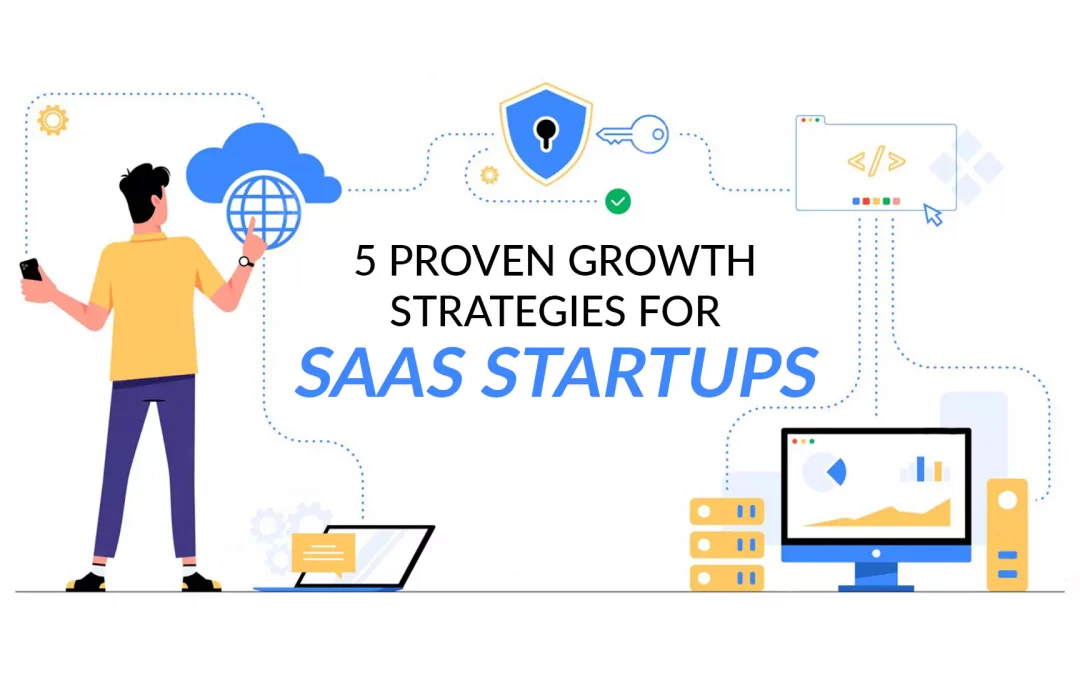Ever wondered how companies like PayPal, HubSpot, Salesforce, Zoom, and Slack have built an army of millions of users globally? Have you ever tried to study the growth strategies that helped these companies grow from SaaS startups to tech giants in just 2-3 decades?
Establishing a SaaS startup is a challenging task. Lack of growth means death, and you cannot even afford to stay behind amid a highly competitive SaaS business landscape. Hence, successful SaaS brands like Salesforce, Zoom, and Grammarly focus on customer retention by continuously innovating their SaaS applications. Besides, they use strong growth-hacking strategies to position themselves as innovative and value-driven brands that care about their users and solve their critical issues.
No matter how productive your SaaS product is, potential users will never beat a path to your door unless you follow proper plans. Hence, follow these proven growth strategies to expand your consumer base and make your SaaS startup a success story.
How to Define the SaaS Growth?
Before we deep dive into SaaS growth tactics, let’s first define SaaS growth to get a better understanding of this concept.
SaaS growth is referred to the rate that indicates the increase in a SaaS company’s revenues and size within a specified period. Net expansion and MRR growth rates are two popular metrics used to calculate the growth of SaaS firms.
Similarly, experts often combine 5 common growth tracks to define SaaS growth as a strategic framework. These tracks include:
- Expansion to new markets
- Monetization
- Upmarket growth
- Downmarket growth
- Product expansion
Growth-hacking Strategies for SaaS Businesses
1. Optimize User Onboarding Experience
A user’s journey with a SaaS company begins with a memorable onboarding experience. Particularly for those startups that offer a limited free trial to new users and try to convince them to long-term engagements.
Hence, the first thing a SaaS startup should do is to optimize the user onboarding experience and give the right impression to their new customers. This will help your company set the tone of your relationship and persuade the user to buy a paid subscription plan.
While there is no definitive way to optimize the user onboarding experience, here are a few points to consider:
- Focus on customer success in your sales strategies
- Understand users’ needs and offer feasible solutions to solve their issues
- Carefully curate the post-sales contract to maintain momentum
- Include personalization, guidance, and highlighting benefits rather than features
2. Maintain Seamless Communication
A SaaS user’s response time is another good way to track brand success. The sooner you get a response, the better you can achieve your desired objectives.
Moreover, keeping an eye on customers’ messages and queries becomes even more important while juggling omnichannel marketing. Both existing and potential SaaS customers expect quick and effective responses to their questions and queries. A slight delay can break the whole chain of communication and negatively affect the buyer’s journey.
Hence, if you want to convert your lead to a long-term customer, maintain seamless communication with users. Besides, leverage automation tools to register more demo signups, track your leads, and optimize customer journeys.
3. Improve Customer Retention
Although new customer acquisition is important for business growth, it is quite expensive and less effective. On the other hand, customer retention is cost-effective and offers long-term success in the form of organizational growth and development.
Therefore, SaaS startups looking to scale should improve their customer retention. There are several ways to achieve this goal, such as providing exceptional customer care, including exclusive features, and investing in product development. Moreover, companies can also offer in-app onboarding and produce value-driven content after a thorough understanding of customer needs.
Some other ways to drive demo signups and product usage include digital marketing, email campaigns, webinars, and promotional videos.
4. Leverage Partnerships
In recent years, joint ventures have emerged as an effective way to grow businesses. Many SaaS startups are nowadays finding new partners to increase their reach and access new users, product knowledge, expertise, and capital.
Joint ventures are a fast way to achieve remarkable business growth quickly without stretching budgets. For this purpose, companies can start affiliate programs to boost their sales and get quality referrals from trusted resources. Besides, you can also enlist customer advocates to drive sales and market your SaaS product in front of new customers.
Finally, SaaS startups can generate additional revenue by analyzing customer lifetime value scores and transforming their customer relationships.
5. Make Data-driven Decisions
Finally, making data-driven decisions based on actionable insights is also critical to accelerating the growth of a SaaS startup. Real-time insights not only keep you informed of your team’s progress but also help you identify potential issues and make timely decisions.
Hence, understand user behavior by analyzing buying patterns and tracking customer acquisition costs. Similarly, keep monitoring the growth of your SaaS startup by regularly analyzing your revenue growth rate. Additionally, use targeted digital marketing campaigns and SEO strategies to reach prospects and convert visitors into loyal customers.
Most importantly, develop an end-to-end digital fulfillment platform to ensure a seamless checkout experience and inspire your target audience.
Wrapping Up
The global SaaS industry is growing at a remarkable rate of 11.0% and is expected to have a market size of $344.3 billion by 2028. While these numbers indicate growth opportunities for SaaS businesses, they also pose new challenges to SaaS startups in terms of growth and sustainability.
To survive in today’s competitive SaaS industry, companies need well-curated growth strategies focusing on optimizing user experiences and improving product quality. From improving user onboarding experience to maintaining seamless communication, SaaS startups should focus on satisfying their customers and meeting their growing needs.
Moreover, they should also improve customer retention, leverage joint ventures and new partnerships, and make informed decisions to achieve remarkable growth.

